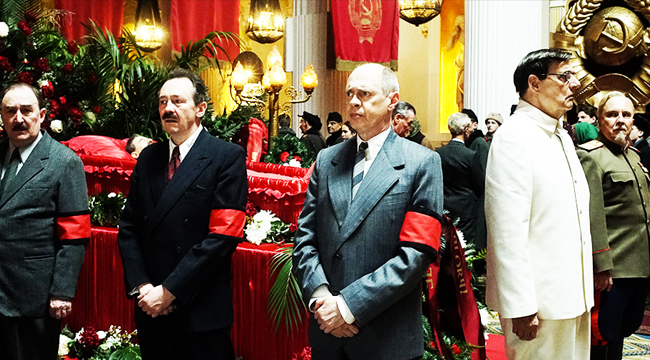
This review originally ran last fall as part of our Fantastic Fest coverage. We are rerunning it as The Death Of Stalin hits theaters, opening in select cities this Friday, March 9th, before expanding.
The most eagerly anticipated event of Fantastic Fest, where Vince Mancini and I have set up shop this week, is the “secret screening.” The only hint attendees are given is none, just a time for when to show up (even the festival’s website taunts, “It’s a secret!!!”) Typically, the slot goes to a horror or science-fiction film, like Split in 2016, or Gravity in 2013, genres routinely associated with lofty body counts. But this year’s secret screening honor went to The Death of Stalin. At first, it seemed like an odd choice — the comedy played the same day as a zombie musical and a biopic about a famed serial killer — but it turns out Stalin has more corpses than most horror movies. That wasn’t the only surprise: it’s also a minor letdown from a brilliant humorist.
Based on the graphic novel of the same name, The Death of Stalin takes place in 1953, the year the General Secretary of the Communist Party of the Soviet Union — spoiler alert — died. The script from Armando Iannucci, who co-wrote the brilliant political satire In the Loop and created HBO’s Veep (before leaving two seasons ago), is interested in what happened next, when Stalin’s bumbling cronies, working under their own self-interest, scramble for the smallest breadcrumbs of consolidated power. If you’ve seen Veep, you know what to expect: general buffoonery; misplaced machismo; in-fighting; chaos.
Iannucci is a master at exposing and blowing out the inherent absurdity amoral politicians, but The Death of Stalin isn’t as funny as his previous shows and movies. Long stretches go by without a joke, especially late in the film, when the likes of Nikita Khrushchev and Lavrentiy Beria (played by the typically fantastic Steve Buscemi and Simon Russell Beale, respectively) break alliances as soon as they’re formed. The Death of Stalin is constantly in motion, and there’s too much plot and too many characters, for the jokes to break through. But even though the script isn’t nearly as quotable as Veep (although, don’t worry, there’s still the occasional “f*ck” and one incredible insult from Rupert Friend as Stalin’s son), Iannucci builds some incredible comedic set pieces. It helps that he has a top-notch cast, including Jason Isaacs’ scene-stealing Georgy Zhukov, Andrea Riseborough’s wide-eyed Svetlana Stalina, and Jeffrey Tambor’s dim Georgy Malenkov (all of whom, in one of the best jokes of the movie, talk without Russian accents), at his disposal. The Death of Stalin singlehandedly takes back the “let’s move a corpse” trope from Weekend at Bernie’s (urine is involved), and the ruthless murders of countless Russians is a constant source of gallows humor.
No, really. Early in the film, Comrade Andreyev, an anxiety-ridden producer played by Paddy Considine, receives a phone call from Stalin, who wants a recording of that night’s orchestra performance… which wasn’t recorded. With half the audience already gone, Andreyev starts pulling in random people, most of whom look like they’ve never been under a roof, from off the street. “Don’t worry,” he says to explain the unexpected encore, “nobody’s going to get killed.” Out of context, it’s not particularly funny, but the threat of murder, for the simple rationale of forgetting to hit “record,” heightens the stakes, and the comedy. That tension only lasts for so long, though, and by the end of The Death of Stalin, which grows increasingly tangled and straight-faced, I was craving a dildo croissant.






